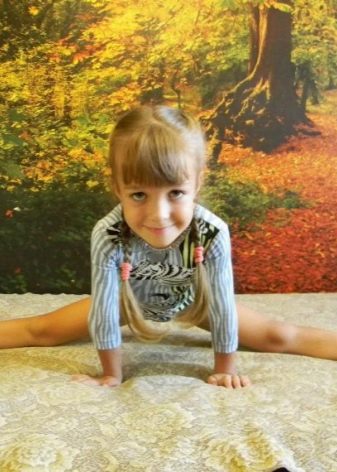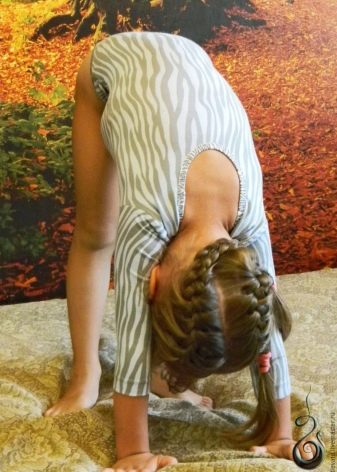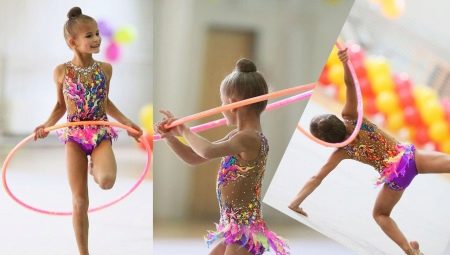Girls who are engaged in rhythmic gymnastics must have their own clothing form - a special swimsuit. You may need several costumes for the performance, it all depends on the number of rooms delivered, and this is already overhead for the budget of the whole family.
It can be sewn at home, having at hand a sewing machine, fabric and a pattern of a swimsuit.
Where to start creating a swimsuit? The title of the next chapter will be the first cheat sheet for those mothers whose daughters engage in this sport.
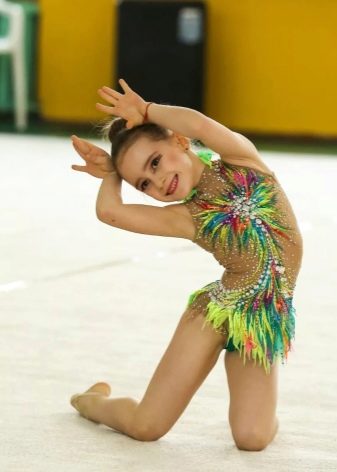
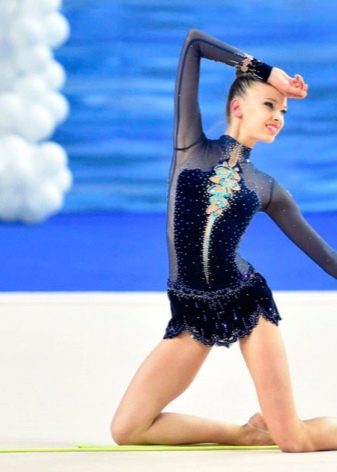
How to build a pattern?
The pattern can be obtained in 3 ways:
- Take the finished drawing. Half-chest and half-waist - measurements that will help determine the pattern of the right size.
- The drawing can be obtained if you outline the old swimsuit (after turning it inside out). This method of obtaining a pattern has its drawbacks: seams interfere with the proper drawing up of a pattern.
- Accurate drawing swimsuit to get with the help of self-build patterns.
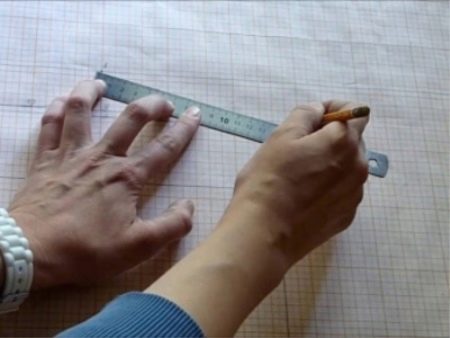
What sizes should be removed to build a swimsuit template?
Legend for sizes:
- O - girth;
- D is the length;
- W - width;
- (O) neck;
- (O) Breasts;
- (O) waist;
- (O) on the lower edge of the swimsuit panties (not to be confused with the hips);
- (O) hands (the tailor's meter must go through the top point and the armpit area);
- (O) wrists;
- (O) enclosures. (The measure is removed without tensioning the tape).

- (D) the shoulder. The measure ends where the shoulder ends;
- (D) sleeves. The measure is taken from the point where the shoulder ended;
- (W) before (measure accurately between hands);
- (W) backs (the measurement is taken similarly to the front and add 3-4 cm);
- (W) panties in front. The line runs about 5-6 cm. Below the girth along the edge of the panties;
- (W) panties on the back;
- (D) the front (measured from the high point of the shoulder to the waist);
- (D) the back (the measurement is reduced by 1 cm);
- (D) the sides (from the armpit to the waist);
- (D) panties (the measure can be taken with ordinary high-waisted panties (not thongs));
- (W) the shoulders (the tape passes through the lower level of one shoulder, the 7th cervical vertebra and the lower level of the second shoulder).
The photo shows how all the measurements are taken.
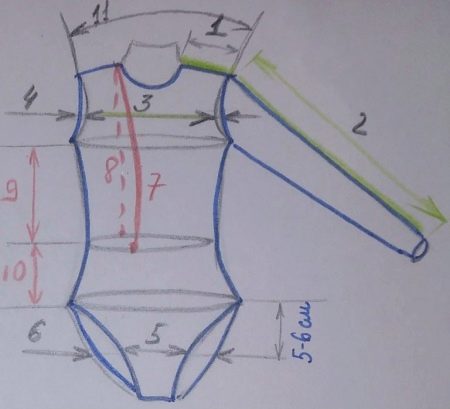
Front and back template
- Mark on top of paper. Vertically down, build two segments equal to 1.5 cm and 5 cm. Outline the neckline.
- Horizontally postpone the following measurement: (W) the shoulder minus 2 shoulder lengths and divide by 2. From the received mark, lower the perpendicular (2-3 cm) and draw a line (we get the shoulder).
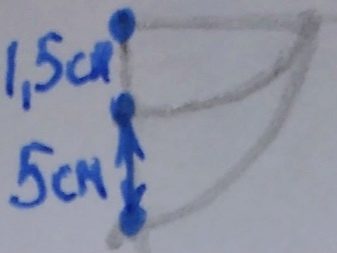
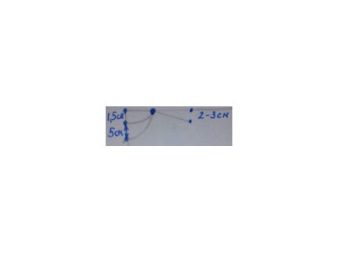
- From the upper point of the shoulder down, postpone measurement No. 7 and draw a line.
- On the line received, lay down the following measurements: No. 7, 8. The waist lines for the main parts are obtained.
- Waist circumference divided by 4. Set the result as a piece from the middle of the leotard through point 8.
- From mark 8 up, postpone measurement No. 9 (side length). From mark 8 down, postpone measurement No. 10. An example of how constructions should look is given in the photo.
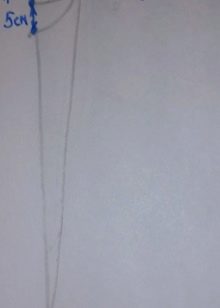
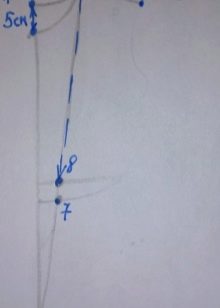
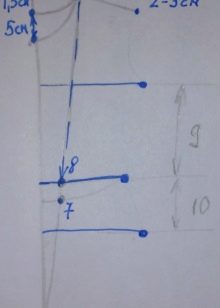
- Next, the chest girth, the girth along the lower edge of the panties divided by 4. From the middle of the leotard, through the points already obtained, postpone the results and draw horizontal lines. These will be the chest line and panty level. Outline the side line.
- From the girth line on the lower edge of the panties, lower the perpendicular 5-6 cm and draw a horizontal line. From the middle of the leotard to the right, set aside: (previously, divide the width of the panties in front and behind by 2).
- Set aside 2.5 cm across the bottom mark. This will be a gusset (patch in panties for ease of movement and body cleanliness). Draw a line of panties on a swimsuit.
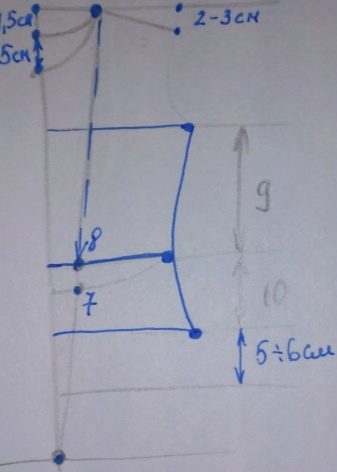

Now it’s worth doing drawing armholes:
- (D) divide the shoulder into 2 equal segments and lower the perpendicular equal to 5-6 cm and draw a horizontal.
- Formula: (W) front and back / 2. Postpone the results as segments. Two marks should come out (the difference between them is about 1 cm). Draw two smooth lines.
Drawings of the main parts are ready.
All constructions of the front fit in the back template. First, the contour of the back is cut out. The backrest scheme should be re-drawn on new paper, then cut out the contour of the front of the swimsuit.

Sleeve pattern
The drawing of the sleeve includes 2 measures: the measure (O) of the arm and (D) the ridge of the sleeve. An ordinary t-shirt will help determine the height of the sleeve’s ok.
The pattern is built quite simply. The photo below illustrates all the constructions. The sleeve drawing itself is similar to an inverted trapezoid. The sleeve sleeves are constructed using an example of a photo.
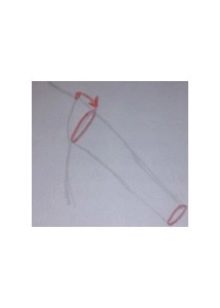
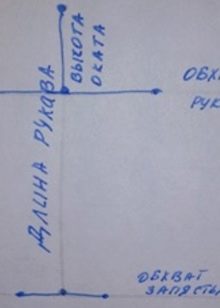
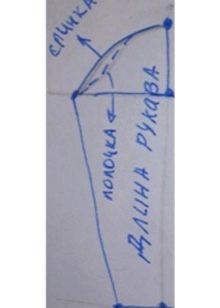
Skirt pattern
The skirt for a bathing suit resembles clothes with a cut in the sun:
- According to the finished template of the front and back, take the measure of half-circumference of the place where the skirt will be sewn.
- Draw a horizontal line on paper. To lay down the perpendicular 2-3 cm down and make a semicircle in a semicircle (the radius of the skirt is equal to the length of the skirt).
The skirt pattern is ready.
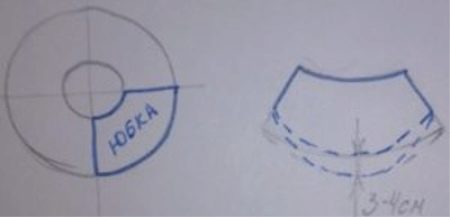
Material
There are certain rules and requirements for tailoring a suit for rhythmic gymnastics. One of the first requirements relates to the choice of material.
According to the requirements of the judging committee, the main part of the gymnast's costume should not be made of transparent fabrics. The body area to the chest of the swimsuit is cut out necessarily from dense materials.
What fabric to choose as the main material and what to buy for finishing a swimsuit?
The base material should stretch well and be moisture resistant. Designers professionals recommend looking at the supplex.
Biflex is a knitted fabric that meets all the requirements. Biflex swimwear fits well. Graceful figures of gymnasts will be emphasized by matte material. Brilliant will give expression and elegance to the costume.The fabric combines perfectly with other materials.
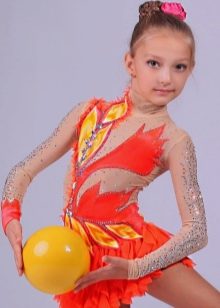
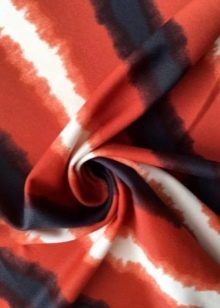

Guipure is a delicate and beautiful fabric with a pattern. He plays his special role. It is used as decoration on a swimsuit or sleeves are cut out. Costumes with guipure trim are distinguished by a special chic and romance.
Velvet is a noble material with a soft short pile. Both the swimsuit itself is sewn from dense iridescent fabric, and it is combined with other materials. Velvet appliques on a swimsuit are a stunning decor on a suit.
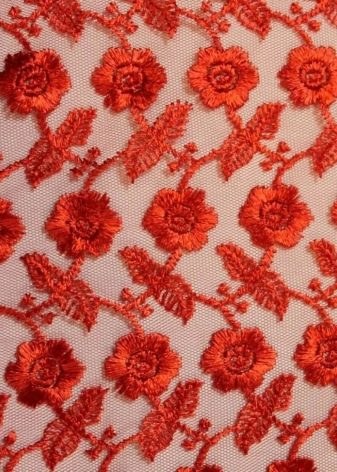
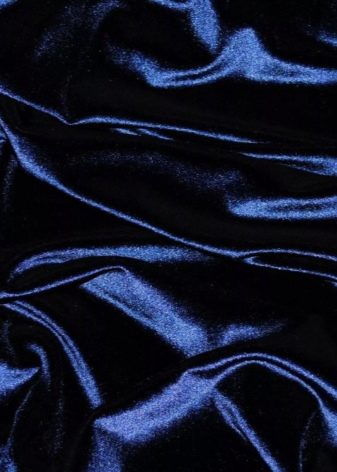
How to make a model for performances with your own hands?
In any sport there are always many performances and competitions. For such events, gymnasts have a costume that is used only for performances. Swimwear is decorated with brighter and more expensive decorative elements, shiny fabrics are used.
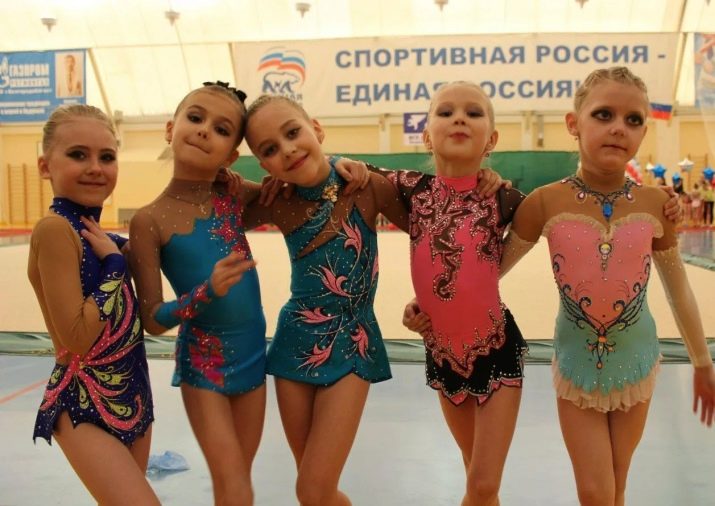
You need to sew a swimsuit for performances in a relaxed home environment. If the footage of the apartment allows, then when making a costume, it is better for mother and daughter to stay alone in the room. This will help to calmly do the fitting and neatly perform all sewing operations and discuss the costume decor.

To sew an outfit for performances, in addition to all of the above items, at the beginning of the article, decorative trim (if provided) and sewing accessories will be required. A detailed workshop on making a swimsuit will be given below.
Attention should be focused only on one point. The application or other decoration on the suit should be done first (while the swimsuit itself is at the preliminary stage before assembly). This will allow you to perform the decor more efficiently and accurately.
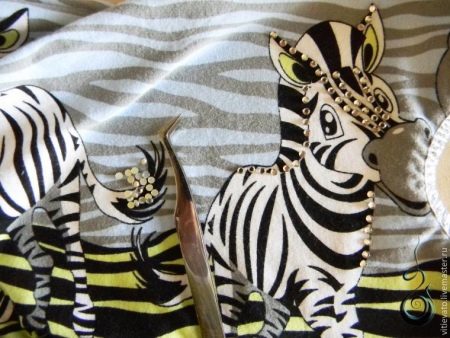
Master Class
The master class includes all the detailed instructions based on the pattern, which can be built from our first chapter:
- Prepare everything you need for cutting and sewing.
- In any swimsuit, there is another irreplaceable gusset piece. On the main parts of the swimsuit, draw the inguinal part (lower part of the panties). Glue two parts of the gusset drawing. Cutting gussets is done in one copy.
- Separately cut out the neckline main details.
- The next stage of sewing will be cutting. Fold the fabric along the shared thread. Pin all patterns with pins on the material. The design of the front, back and skirts should lie on the fold of the fabric. Cut out all parts of the swimsuit with seam allowances.
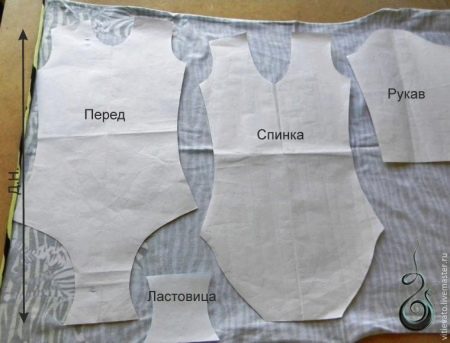
- Bottom swimsuit to sew and sew on the machine. Now is the gusset line. Gusset cuts out in a single copy. Process the gusset width with a zigzag stitch, open sections of the gusset length will go into the seam.
- Apply the gusset face to the inside of the leotard. This is a very inconvenient place for laying the machine stitch, therefore it is recommended to gusset to sweep to the swimsuit a little further away from open sections.
Open gusset sections can be processed in 2 ways:
- Sweep open sections onto the seamy side of the leotard without bending and sew on a zigzag stitch or overcast on the overlock.
- Sweep the gusset edges with a seam in the hem and lay the machine line.
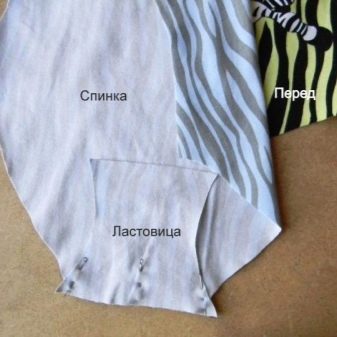
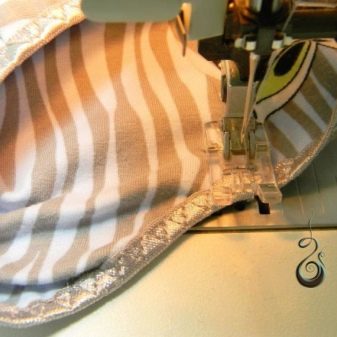
How to sew a gusset on a swimsuit? Watch the video tutorial.
Left:
- Process the edges of the skirt with a seam in the hem with a closed cut. Next, sweep the skirt to the intended place on the swimsuit. Sew on a skirt by car.
- Combine side sections of sleeves, Sweep and flash. Tuck the bottom of the sleeves and seam with a closed cut.
- Stitch the shoulder sections of the swimsuit. In the armhole of a suit, sweep sleeves. Try on the entire swimsuit. After fitting, the sleeves are stitched on the machine.
- We process the neck with a grinder.
The costume is ready.
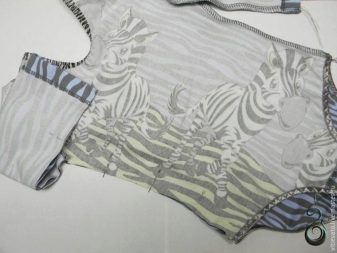
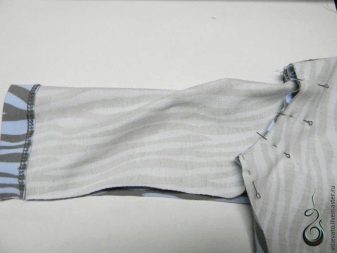
If you strictly follow the step-by-step instructions, then tailoring a leotard for rhythmic gymnastics will not be difficult even for beginners. Crafts, supported by a good mood, will create masterpieces for training and performances in rhythmic gymnastics.Successful undertakings and success in the performance of all sewing operations.
